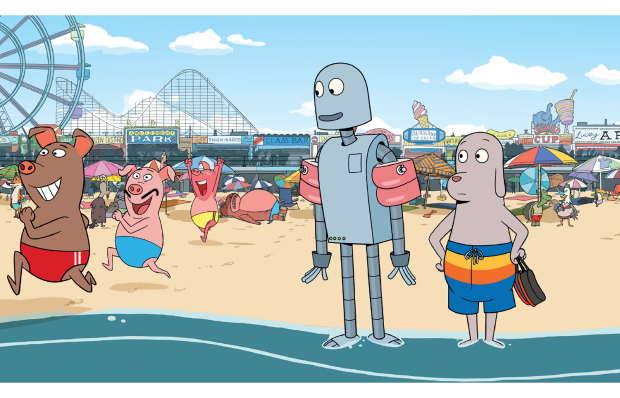Belle is based on the true story of Dido Elizabeth Belle, the illegitimate, mixed-race daughter of a sea captain and his African slave mistress, who was brought up as a free gentlewoman by her great uncle, Lord Mansfield, at Kenwood House, Hampstead, in the 18th century. How fascinating, you might think. You just can’t mess up with a story like this, you might also think. It has everything going for it; a costume drama fulfilling all our beloved Jane Austen tropes (class, gender, etc.) with the added charge of race. How could it go wrong? Alas, all too easily. This is disappointingly lifeless, and shallow, and the soundtrack! So many violins, you’ll leave feeling as if you’ve been quite violently smacked around the head with one. Repeatedly.
This is written by Misan Sagay, who was inspired after seeing Johann Zoffany’s painting of Dido with her cousin, Lady Elizabeth Murray, which now belongs to the current Lord Mansfield, and hangs in Scone Palace, Scotland. This is a painting I have been familiar with since childhood as I grew up near Kenwood, and have just always known about it somehow. I can recall it from memory. There is Elizabeth, who is white and attired in a pink frothy frock, gazing out passively while, just to the right, stands Dido, who is carrying exotic fruit, wearing a turban adorned with a feather, and has a vivacious glint in her eye. The pair are presented as equals, with Elizabeth laying an affectionate hand on Dido’s waist. I do not think you can look at this painting without asking the questions Sagay must have asked: who was Dido? How was she treated, as a black woman in high society? What became of her? Because so little is actually known, much of this film is conjecture, but it is not high-class, believable conjecture. It is fluffy, formulaic conjecture, with violins.

Directed by Amma Asante, this opens as Dido’s father, Captain Sir John Lindsay (Matthew Goode), deposits Dido at Kenwood when she is six years old, her mother having died. The household, at that time, consisted of Lord and Lady Mansfield (Tom Wilkinson and Emily Watson), a maiden aunt (Penelope Wilton, who seems to have been playing maiden aunts since for ever) and a grand-niece, Elizabeth, who is Belle’s age. The family are initially discombobulated. ‘She is black!,’ says the aunt. ‘She is my blood,’ says Lindsay. ‘But she is black,’ protests Lady Mansfield. However, they come to love her, affording her the same privileges as Elizabeth, as far as possible.
The little girls become young women, as played by Gugu Mbatha-Raw (Dido) and Sarah Gadon (Elizabeth), and as close as the Bennett sisters, on whom they have obviously been modelled. But Dido’s colour cannot be overlooked. She cannot, for example, dine with the family when guests are present. We know this because, as Dido says to Lady Mansfield: ‘How can I be too high of rank to dine with the servants, but too low of rank to dine with my own family?’ The script is laden with such expositionary clangers; with everyone telling rather than showing, pointing out exactly how the land lies to those who would know. This is not a subtly textured or layered film, in other words. In fact, there are more petticoats of exposition in this than there are actual petticoats, and there are many, many of those.
The women fret about their marriage prospects and, even though Dido becomes an heiress after her father dies, she is still considered less marriageable than her white penniless cousin. But the racism is never tackled convincingly, or even seriously. There is one horrible moment, but it’s handled with such ludicrous clumsiness I’m not sure it counts. Everything is laid on thick, including a parallel plot concerning the abolition of slavery.
Lord Mansfield, in his capacity as Lord Chief Justice, is about to rule on the Zong massacre, whereby a ship’s crew has been accused of deliberately drowning their cargo of slaves to claim the insurance. Dido, together with John Davinier (Sam Reid), a swooningly dishy vicar’s son with impassioned anti-slavery views, seek to influence the case in ways that seem as false as they actually are. (There was a Davinier, but he was none of the things this film says he is.) Also, Dido and Davinier hate each other when they first meet, so I think we always know where that is going. Also, Lady Mansfield ticks off Lord Mansfield for not being the man she married, for not having fire in his belly any more, and I think we always know where that is going too.
Aside from a cameo by Miranda Richardson, which adds some vim, no character properly comes to life. Even the usually dependable Wilkinson seems leaden — he just ponders everything in a kindly way — while Mbatha-Raw always seems on the verge of tears, as those violins swell. You can see the film or not — makes no difference to me — but, if I were you, I’d opt for the painting instead. It’s better. And more interesting, too.
Got something to add? Join the discussion and comment below.
Get 10 issues for just $10
Subscribe to The Spectator Australia today for the next 10 magazine issues, plus full online access, for just $10.
You might disagree with half of it, but you’ll enjoy reading all of it. Try your first month for free, then just $2 a week for the remainder of your first year.













Comments
Don't miss out
Join the conversation with other Spectator Australia readers. Subscribe to leave a comment.
SUBSCRIBEAlready a subscriber? Log in